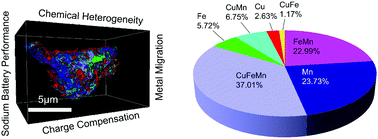当前位置:
X-MOL 学术
›
Energy Environ. Sci.
›
论文详情
Our official English website, www.x-mol.net, welcomes your
feedback! (Note: you will need to create a separate account there.)
Empowering multicomponent cathode materials for sodium ion batteries by exploring three-dimensional compositional heterogeneities†
Energy & Environmental Science ( IF 32.4 ) Pub Date : 2018-06-25 00:00:00 , DOI: 10.1039/c8ee00309b Muhammad Mominur Rahman 1, 2, 3, 4 , Yahong Xu 4, 5, 6, 7 , Hao Cheng 8, 9, 10, 11, 12 , Qianli Shi 1, 2, 3, 4 , Ronghui Kou 4, 13, 14, 15, 16 , Linqin Mu 1, 2, 3, 4 , Qi Liu 17, 18, 19, 20 , Sihao Xia 4, 5, 6, 7 , Xianghui Xiao 4, 13, 14, 15, 16 , Cheng-Jun Sun 4, 13, 14, 15, 16 , Dimosthenis Sokaras 4, 5, 6, 7 , Dennis Nordlund 4, 5, 6, 7 , Jin-Cheng Zheng 8, 9, 10, 11, 12 , Yijin Liu 4, 5, 6, 7 , Feng Lin 1, 2, 3, 4
Energy & Environmental Science ( IF 32.4 ) Pub Date : 2018-06-25 00:00:00 , DOI: 10.1039/c8ee00309b Muhammad Mominur Rahman 1, 2, 3, 4 , Yahong Xu 4, 5, 6, 7 , Hao Cheng 8, 9, 10, 11, 12 , Qianli Shi 1, 2, 3, 4 , Ronghui Kou 4, 13, 14, 15, 16 , Linqin Mu 1, 2, 3, 4 , Qi Liu 17, 18, 19, 20 , Sihao Xia 4, 5, 6, 7 , Xianghui Xiao 4, 13, 14, 15, 16 , Cheng-Jun Sun 4, 13, 14, 15, 16 , Dimosthenis Sokaras 4, 5, 6, 7 , Dennis Nordlund 4, 5, 6, 7 , Jin-Cheng Zheng 8, 9, 10, 11, 12 , Yijin Liu 4, 5, 6, 7 , Feng Lin 1, 2, 3, 4
Affiliation

|
Affordable sodium ion batteries hold great promise for revolutionizing stationary energy storage technologies. Sodium layered cathode materials are usually multicomponent transition metal (TM) oxides and each TM plays a unique role in the operating cathode chemistry, e.g., redox activity, structural stabilization. Engineering the three-dimensional (3D) distribution of TM cations in individual cathode particles can take advantage of a depth-dependent charging mechanism and enable a path towards tuning local TM–O chemical environments and building resilience against cathode–electrolyte interfacial reactions that are responsible for capacity fading, voltage decay and safety hazards. In this study, we create 3D compositional heterogeneity in a ternary and biphasic (O3–P3) sodium layered cathode material (Na0.9Cu0.2Fe0.28Mn0.52O2). The cells containing this material deliver stable voltage profiles, and discharge capacities of 125 mA h g−1 at C/10 with almost no capacity fading after 100 cycles and 75 mA h g−1 at 1C with negligible capacity fading after 200 cycles. The direct performance comparison shows that this material outperforms other materials with similar global compositions but different mesoscale chemical distributions. Synchrotron X-ray spectroscopy/imaging and density functional theory studies reveal depth-dependent chemical environments due to changes to factors such as charge compensation and strength of orbital hybridization. Finally, 3D spectroscopic tomography illuminates the path towards optimizing multicomponent sodium layered cathode materials, to prevent the migration of TMs upon prolonged cycling. The study reports an inaugural effort of multifaceted and counterintuitive investigation of sodium layered cathode materials and strongly implies that there is plenty of room at the bottom by tuning nano/meso scale chemical distributions for stable cathode chemistry.
中文翻译:

通过探索三维组成异质性,为钠离子电池多组分正极材料提供支持†
负担得起的钠离子电池在革新固定式储能技术方面具有广阔的前景。钠层阴极材料通常是多组分过渡金属(TM)氧化物,并且每种TM在运行中的阴极化学(例如氧化还原活性,结构稳定化)中都扮演着独特的角色。设计单个阴极颗粒中TM阳离子的三维(3D)分布可以利用深度依赖的充电机制,并为调整局部TM-O化学环境和增强对负责的阴极-电解质界面反应的适应性提供一条途径用于容量衰减,电压衰减和安全隐患。在这项研究中,我们在三元和两相(O3-P3)钠层阴极材料(Na0.9 Cu 0.2 Fe 0.28 Mn 0.52 O 2)。包含这种材料的电池可提供稳定的电压曲线,在C / 10时的放电容量为125 mA hg -1,经过100次循环和75 mA hg -1后几乎没有容量衰减在1°C下200次循环后容量可忽略不计。直接性能比较表明,这种材料优于具有相似总体组成但中尺度化学分布不同的其他材料。同步加速器X射线光谱/成像和密度泛函理论研究表明,由于电荷补偿和轨道杂交强度等因素的变化,深度依赖于化学环境。最后,3D光谱层析成像为优化多组分钠层阴极材料提供了途径,以防止长时间循环后TM的迁移。
更新日期:2018-06-25
中文翻译:

通过探索三维组成异质性,为钠离子电池多组分正极材料提供支持†
负担得起的钠离子电池在革新固定式储能技术方面具有广阔的前景。钠层阴极材料通常是多组分过渡金属(TM)氧化物,并且每种TM在运行中的阴极化学(例如氧化还原活性,结构稳定化)中都扮演着独特的角色。设计单个阴极颗粒中TM阳离子的三维(3D)分布可以利用深度依赖的充电机制,并为调整局部TM-O化学环境和增强对负责的阴极-电解质界面反应的适应性提供一条途径用于容量衰减,电压衰减和安全隐患。在这项研究中,我们在三元和两相(O3-P3)钠层阴极材料(Na0.9 Cu 0.2 Fe 0.28 Mn 0.52 O 2)。包含这种材料的电池可提供稳定的电压曲线,在C / 10时的放电容量为125 mA hg -1,经过100次循环和75 mA hg -1后几乎没有容量衰减在1°C下200次循环后容量可忽略不计。直接性能比较表明,这种材料优于具有相似总体组成但中尺度化学分布不同的其他材料。同步加速器X射线光谱/成像和密度泛函理论研究表明,由于电荷补偿和轨道杂交强度等因素的变化,深度依赖于化学环境。最后,3D光谱层析成像为优化多组分钠层阴极材料提供了途径,以防止长时间循环后TM的迁移。











































 京公网安备 11010802027423号
京公网安备 11010802027423号